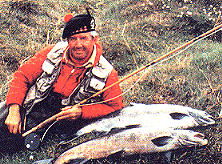Corral Creek Run
By Charlie Kroll
The year, 1960. The time, mid-September. The place,
central British Columbia, the Kispiox River valley 50 miles north
of Hazelton. The party, Fred Bear and I, with a bow hunt for
grizzlies uppermost in mind, plus Knick Knickerbocker of
Crozet, Virginia and George Griffith of Graying, Michigan who
were along to tangle with the great migrant steelhead of the region.
We were headquartered at Jack Lee's cabin camp, where
Corral Creek runs into the Kispiox. Jack had driven us in from
our air arrival point at Smithers, over a gravel road that was
fairly good going out of Hazelton but that gradually downgraded
to bush road status as we progressed up the wide, forested valley.
At one point we crossed a wooden bridge spanning a deep stream
cleft. The rough sign at the bridge proclaimed this to be "Nobody
Much Creek." When Fred asked Jack how it got that name, the
outfitter replied, "Well, before the bridge was put in, nobody much
got beyond that spot in a car."
Jack, incidentally, was a remnant of a now vanishing breed, hard
working and self sufficient pioneer stock. He was intimately familiar
with the surrounding wilderness, largely the result of a rough winter
during the Great Depression of the 1930s when he had taken to the
forest with nothing but snowshoes, bedroll, a single shot .22 rifle and
some salt. He hunted red squirrels for their pelts, which at the time
were worth 10 cents apiece, and lived largly on the small carcasses of
his quarry. It was a time of constant travel, walking along looking for
a new target while skinnning with his pocket knife the last one taken.
By the time he came out in the spring, Jack had bagged more than
3,000 squirrels and in the process had become familiar with every
nook and cranny he would later take over as a guiding territory.
At that time this north central wilderness of British Columbia
was a land of primeval beauty, lushly forested with huge spruce and
fir, dotted with innumerable lakes and criss-crossed by the valleys
and gorges of such mightly river systems are the Nass, Nelson, Dease
and Skeena.
The great Skeena watershed system rises in the heart of interior
Stokine, Skeena and Omineca ranges and fed by sizable tributaries
such as the Bulkley, Babine, Morice, Sustut, Copper and Kispiox,
winds its way 500 miles to the Pacific south of Prince Rupert.
North of Hazelton the timbered mountains stretched out in wild
profusion for 300 miles, for the most part unmarred by human
habitation but supporting a wealth of mountain sheep and mountain
goats, moose, caribou, wolves and bears, both black and grizzly.
Outfitters' pack strings periodically penetrated some of the more
accessible portions of this area but most of the country remained
aloof and pristine.
In terms of both number and size of fish the Skeena system
has long been the world's top producer of steelhead. The steelhead
is an anadromous strain of the rainbow trout. It is one of the world's
truly great fresh water game fish; in fighting qualities the Pacific Ocean's
equivalent to the Atlantic's Salmo salar. In general
habits and life history the steelhead is also close to the Atlantic Salmon,
the one big exception is that he feeds while in fresh water.
For many years it was thought the steelhead would not take flies, an
unfortunate belief that downgraded their reputation as a game fish and,
because commercial fishing was given priority over sportfishing, led to
unnecessary depletion of the stock. Steelhead (named for the hardness
of the bone structure in the skull) are hereditary in their sea-running cycle
and their spawning runs up into the interior rivers take place largely in
September and October.
While Fred and I were attempting to encounter one of the region's grizzlies,
George and Knick had taken several fine steelhead on light spinning tackle,
the fish ranging from 12 to 17 pounds and had hooked and lost even
larger ones. They reported the river full of fish, which sorely tested my
bow hunting determination.
I did take one midday hike to nearby Skunsnat Lake, where I managed
to catch enough one to three pound cutthroat trout to feed our group
that evening. A rubber raft Jack had cached on the lake shore and the
uneducated and eager trout combined to make it a relaxed and
pleasurable change of pace.

Then, two days before the end of our stay, I had the thrill of a successful
encounter with a grizzly, one of the first to be taken in modern times with
the bow and broadhead arrow. My luck was really at its height, for this
left me with time enough to give the Kispiox steelhead a try. I wasted
no time taking advantage of it.
Concluded Next time! ~ Charlie Kroll
Excerpt from: Pools of Memory
Published by: Frank Amato Publications, Inc.
P.O. Box 82112, Portland Oregon 97282 Phone: 503-653-8108,
email Frank Amato Publications
Our Man In Canada Archives
|



